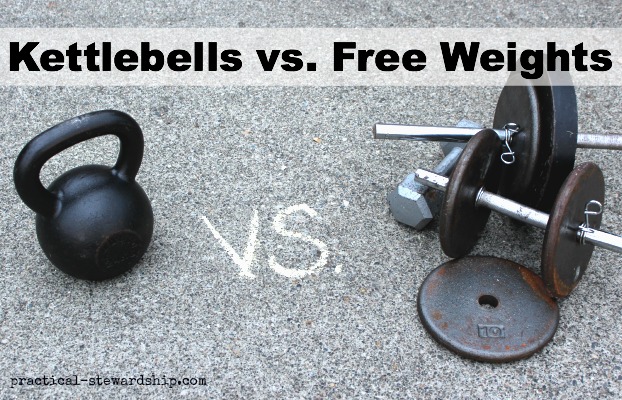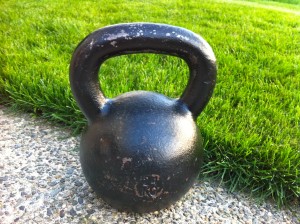
We continue today with our debate about which is better (if we can call it a debate), and this is my second installment.
Before I move on, keep in mind that when we ask which is better between kettlebells and free weights/barbells, it is sort of like asking which is better between hatchets and hammers. They serve many of the same functions, and some different ones. But I would argue that where their functions overlap (e.g., fat loss, conditioning, the development of functional strength), kettlebells have barbells beat.
My last post touched on one area where I believe that barbells cannot compete with kettlebells, namely the area of utility. If you missed that post, it may be worth reading before continuing with this one.

Today I’d like to touch on a separate heading altogether: practicality. I have found kettlbells to be far more practical to use than barbells, and here are a few reasons why.
Kettlebells allow me to train where I want.
I train at home, by myself, mostly. In my home office, to be specific. When I train with barbells, I’m confined to my (now frigid) garage or a gym. Not so with kettlebells.
When I travel, I almost always take a kettlebell or two along with me. I could never do that with a weight set. And I don’t compromise the quality of the workouts in the process. If the weather is nice, I can train outside by simply taking my kettlebells outside. The park? The yard? Playground? Office? All great places to work out, and more than possible with the portability of kettlebells. I even exercised on I-90 during a 45-minute delay due to road construction one time last September. I did some swings and snatches with my family.
On a related note…
Kettlebells take up very little space.
My kettlebells occupy about four square feet in a corner of my home office, and they’re just about all I need (I stash a pull-up bar behind the couch when it’s not hanging).
Because you can get a fantastic aerobic or anaerobic workout with minimal equipment, I would recommend kettlebells for any college student who wants to work out in his dorm room. Or anyone who lives in an apartment where space is at a premium. Or anyone who doesn’t want a weights to dominate the visual landscape of his home, but who cannot always make it to the gym.
Kettlebell training doesn’t require a spotter.
I almost always work out alone, which is nice since kettlebell training doesn’t require a spotter. Conversely, working with barbells, it’s smart to have a spotter…or to stay clear of certain exercises (e.g., heavy bench press).
Kettlebells require no set-up.
When kettlebell training, I don’t have to pull out and put away equipment. I move the bells a couple of feet and start swinging. With my weights, I have to set up and tear down, and for many folks, this can provide yet another excuse to not exercise. For the unmotivated, not having to set up equipment eliminates another barrier to exercise.
As for my weight bench and bars, those are in storage, because I am not using them. Every time I want to use them, I need to set up and tear down (we choose to park our cars in the garage, so that means I can’t have weights set up all the time). I refuse to pay for a gym membership, and I suspect that by training at home versus paying for a gym membership, I’ve saved thousands of dollars over the years.
Kettlebell drills are comparatively simple.
For as effective and beneficial as they are, learning to use kettlebells is relatively simple. I could teach an interested athlete the basics of the kettlebell snatch in one session. Same with the swing or clean and press. Not so with the barbell snatch, military press or deadlift. Those are more complicated and technical movements.
Don’t get me wrong: these kettlebell drills are not easy, but neither are they complicated (an important distinction). This makes them more accessible than many of their barbell counterparts.
Note that I’ve only really talked about the practicality of using kettlebells vs. barbells; both are practical in the functionality of the movements involved, though I believe kettlebells to have the edge here, too. Learning to press a kettlebell over your head will equip you to be able to press other heavy stuff over your head, too. Doing snatches and swings (and even military presses) help build pull-up and back strength. You get the idea.
I have one more installment in this miniature diatribe, so stay tuned!
As always, you’re welcome to offer your impressions and experiences in the comments below!
Other Fitness articles from PS.C:
Why Kettlebells Are Better than Barbells: Utility
Favorite Fifteen No. 2: Kettlebell Clean and Press Ladders
